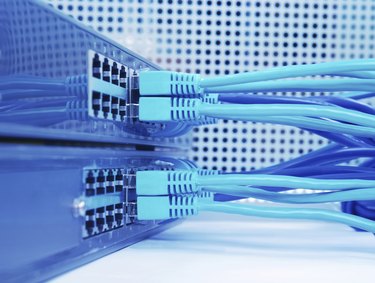
RAS is a term that represents a variety of computer networking tools. It can stand for several potential tools, depending on the context in which it is used. Network Driver Interface Specification (NDIS), on the other hand, refers to one specific type of networking software. Many businesses use computer networking of one type or another, so both terms tend to occur often in professional settings.
RAS
Video of the Day
Remote Access Service (RAS) can refer to several computing terms and services. It is a feature of Microsoft Windows 2000 Server that uses a modem to connect remote users to the network. RAS is also short for Reliability, Availability, Serviceability, a term originated by IBM to reference a computer's overall ability to provide each of these three traits. Other technical terms often shortened to RAS include Row Address Strobe -- a signal used to activate a row address in a dynamic random access memory (DRAM) circuit -- and Registration, Admission and Signaling -- a message control channel used by H.323 audio/video systems.
Video of the Day
Remote Access Server
RAS is also short for "remote access server." Other terms for a remote access server are "media gateway" and "network access server." The purpose of a network access server is to provide users in distant locations with access to a company's internal network. When authentication is necessary, some network servers are equipped to perform the required services themselves. If they are not, an additional authentication server can be used instead.
NDIS
NDIS is an interface program that works in conjunction with network interface cards (NICs). Under normal operating conditions, a single NIC can only support one network protocol. NDIS removes this limitation. Originally developed by Microsoft as a Windows interface, NDIS makes it possible for multiple network protocols to run in tandem without the need for multiple NICs. Open Data-Link Interface (ODI) is a similar program developed exclusively for NetWare.
Network Interface Card
NICs are devices used to enable a computer to connect -- or interface -- with an external network. NICs are usually purchased separately and inserted into a computer only if needed. Different media, network and protocol types generally require their own specific NICs. This means that except under special circumstances, most NICs are not designed to serve more than one network.